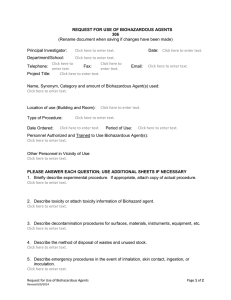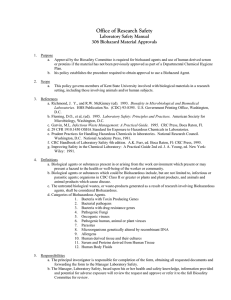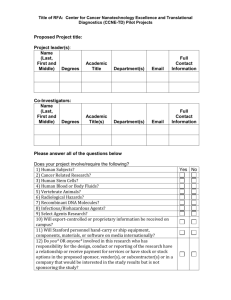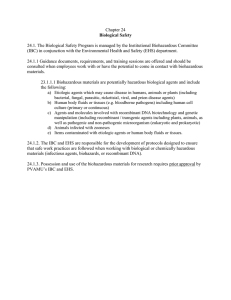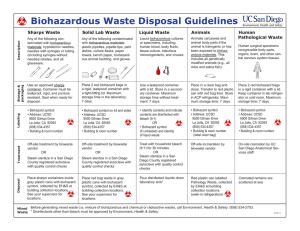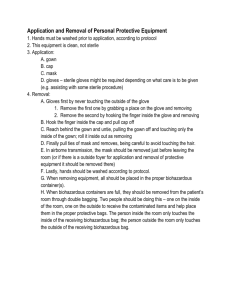Office of Research Safety Laboratory Safety Manual 305 Research with Biological Materials
advertisement
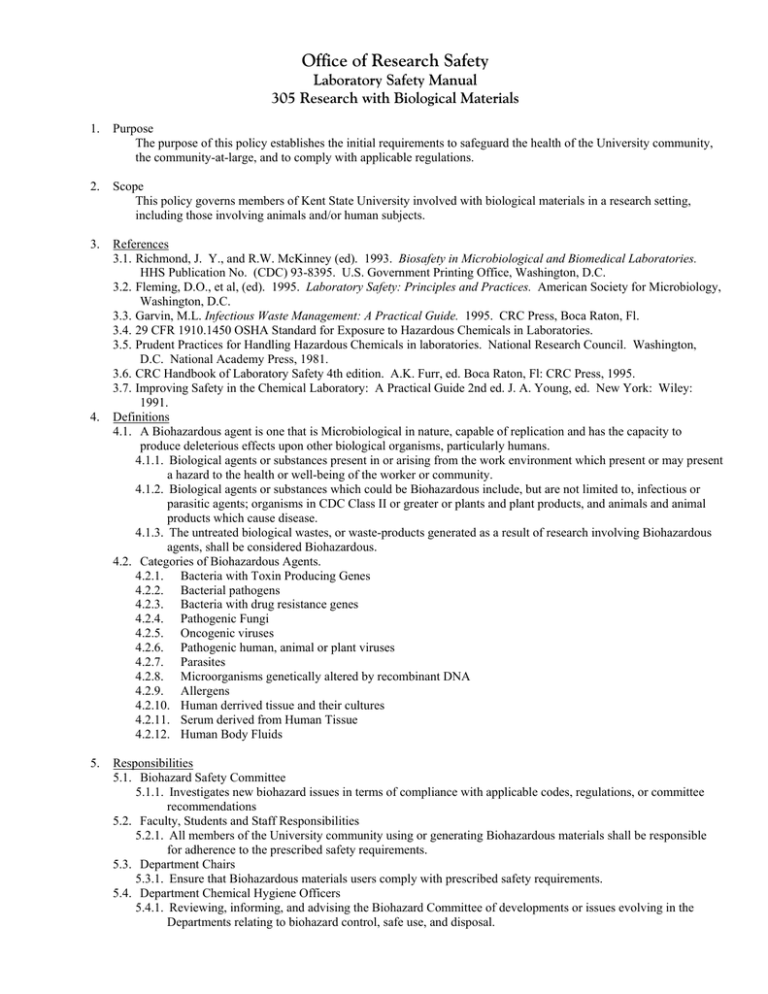
Office of Research Safety Laboratory Safety Manual 305 Research with Biological Materials 1. Purpose The purpose of this policy establishes the initial requirements to safeguard the health of the University community, the community-at-large, and to comply with applicable regulations. 2. Scope This policy governs members of Kent State University involved with biological materials in a research setting, including those involving animals and/or human subjects. 3. References 3.1. Richmond, J. Y., and R.W. McKinney (ed). 1993. Biosafety in Microbiological and Biomedical Laboratories. HHS Publication No. (CDC) 93-8395. U.S. Government Printing Office, Washington, D.C. 3.2. Fleming, D.O., et al, (ed). 1995. Laboratory Safety: Principles and Practices. American Society for Microbiology, Washington, D.C. 3.3. Garvin, M.L. Infectious Waste Management: A Practical Guide. 1995. CRC Press, Boca Raton, Fl. 3.4. 29 CFR 1910.1450 OSHA Standard for Exposure to Hazardous Chemicals in Laboratories. 3.5. Prudent Practices for Handling Hazardous Chemicals in laboratories. National Research Council. Washington, D.C. National Academy Press, 1981. 3.6. CRC Handbook of Laboratory Safety 4th edition. A.K. Furr, ed. Boca Raton, Fl: CRC Press, 1995. 3.7. Improving Safety in the Chemical Laboratory: A Practical Guide 2nd ed. J. A. Young, ed. New York: Wiley: 1991. Definitions 4.1. A Biohazardous agent is one that is Microbiological in nature, capable of replication and has the capacity to produce deleterious effects upon other biological organisms, particularly humans. 4.1.1. Biological agents or substances present in or arising from the work environment which present or may present a hazard to the health or well-being of the worker or community. 4.1.2. Biological agents or substances which could be Biohazardous include, but are not limited to, infectious or parasitic agents; organisms in CDC Class II or greater or plants and plant products, and animals and animal products which cause disease. 4.1.3. The untreated biological wastes, or waste-products generated as a result of research involving Biohazardous agents, shall be considered Biohazardous. 4.2. Categories of Biohazardous Agents. 4.2.1. Bacteria with Toxin Producing Genes 4.2.2. Bacterial pathogens 4.2.3. Bacteria with drug resistance genes 4.2.4. Pathogenic Fungi 4.2.5. Oncogenic viruses 4.2.6. Pathogenic human, animal or plant viruses 4.2.7. Parasites 4.2.8. Microorganisms genetically altered by recombinant DNA 4.2.9. Allergens 4.2.10. Human derrived tissue and their cultures 4.2.11. Serum derived from Human Tissue 4.2.12. Human Body Fluids 4. 5. Responsibilities 5.1. Biohazard Safety Committee 5.1.1. Investigates new biohazard issues in terms of compliance with applicable codes, regulations, or committee recommendations 5.2. Faculty, Students and Staff Responsibilities 5.2.1. All members of the University community using or generating Biohazardous materials shall be responsible for adherence to the prescribed safety requirements. 5.3. Department Chairs 5.3.1. Ensure that Biohazardous materials users comply with prescribed safety requirements. 5.4. Department Chemical Hygiene Officers 5.4.1. Reviewing, informing, and advising the Biohazard Committee of developments or issues evolving in the Departments relating to biohazard control, safe use, and disposal. 5.5. Research and Graduate Studies Department 5.5.1. Repository of forms, policies and reference relating to Biohazardous agents. 6. General Statement of Policy 6.1. It shall be the policy of Kent State University to comply with and adhere to the most recent version of Biosafety in Microbiological and Biomedical Laboratories, as published by the Centers for Disease Control and the National Institutes of Health and codified in the most current, applicable issue of the Federal Register. 7. Universal Precautions for Handling Biohazardous Materials 7.1. Employees must understand the principles of safe microbiological practices before working with Biohazardous materials. Examples include use of aseptic technique, proper decontamination procedures, emergency biohazard spill management and proper use of Biosafety equipment. Proficiency should be developed before beginning work with hazardous materials. 7.2. Aerosols generated from biological specimens are a major potential source of infection for many pathogenic agents, some of which can contaminate human blood and body fluids. Avoid aerosol-generating activities in handling human materials or microbial preparations. When such procedures are unavoidable, use safety cabinets or other containment/protection equipment. Droplets generated by fluorescent activated cell sorters and other automated devices represent potentially infectious aerosols. Translucent plastic shielding between the droplet/collecting area and the equipment operator may be used to reduce the risk. 7.3. Use protocols that are appropriate to the task. 7.4. Use personal protective equipment as required. 7.5. Wash hands often especially AFTER removing gloves. 7.6. Use biological hoods as needed to avoid contaminating an entire room. 7.7. Affix biohazard labels to all equipment where Biohazardous materials are used such as refrigerators, hoods, entry doors, storage rooms. 7.8. Never store food or consumables where Biohazardous materials are stored. 7.9. Employees are required to wear disposable, single-use gloves when performing tasks that will bring them in contact with blood or other potentially infectious materials or contaminated items or surfaces. 7.10. Gloves are removed inside out aseptically and are placed immediately into a biohazard bag or container with the biohazard label. 7.11. Gloves are NOT to be washed for reuse, or disinfected while wearing them. 7.12. Hypoallergenic gloves are furnished to employees allergic to the regular gloves provided.
